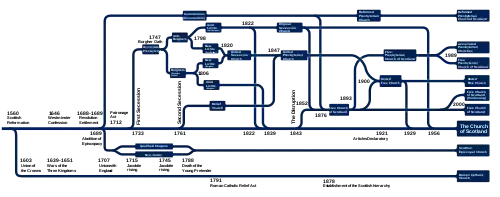Anti-Burgher
The Anti-Burghers were opponents of the Burgher Oath on theological grounds.[1]

In 1733 the First Secession from the Church of Scotland resulted in the creation of the "Associate Presbytery". This church split in 1747 over the issue of the Burgher Oath, which required holders of public offices to affirm approval of the religion "presently professed in this kingdom". The issue was civil compulsion in religious affairs, a forerunner of later arguments over the separation of church and state. Opponents of the Burgher Oath on theological grounds became known as the Anti-Burghers — showing a distinctive independence of conviction and an unwillingness to compromise over sincerely held beliefs. The Burgher and Anti-Burgher factions thus formed rival, independent synods.
Eventually both the Burghers and Anti-Burghers had further splits, the Burghers in 1798 and the Anti-Burghers in 1806. Both factions formed their own, separate "Auld Licht" (old light) and "New Licht" factions. The more Calvinistic "Auld Lichts" held to the obligations of the Solemn League and Covenant, the "New Lichts" were more theologically liberal — a notable and continuing influence in the post-1847 United Presbyterian Church of Scotland.
In 1820, the New Licht Anti-Burghers and the New Licht Burghers united as the United Secession Church, which in turn united with the Relief Church in 1847 to create the United Presbyterian Church of Scotland, which united with most of the Free Church of Scotland in 1900 to create the United Free Church of Scotland, most of whom ultimately reunited with the Church of Scotland in 1929.
The Anti-Burgher Auld Lichts became part of the United Original Secession Church in 1822, which split in 1852, one party joining in the Free Church of Scotland, the others finally reuniting with the Church of Scotland in 1956.
Notable Anti-Burghers
- Adam Gib
- Thomas M'Crie, the elder
- Thomas M'Crie, the younger
- Alexander Moncrieff
References
- Smith, Richard M. (2006). "Auld Licht, New Licht and Original Secessionists in Scotland and Ulster". Scottish Church History Society: 97–124. Retrieved 25 August 2018.
- Bibliography
- McKerrow, John (1839). "Controversy Respecting the Burgess-Oath". History of the Secession Church. Edinburgh: William Oliphant and Son. pp. 272–278.
